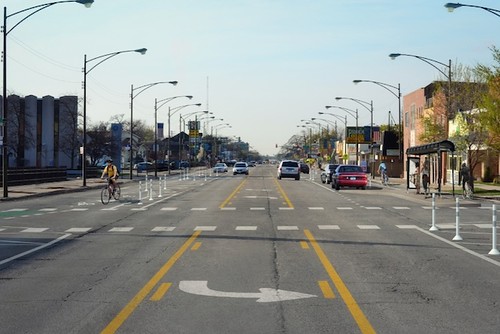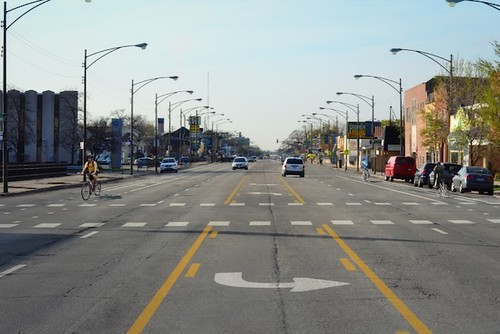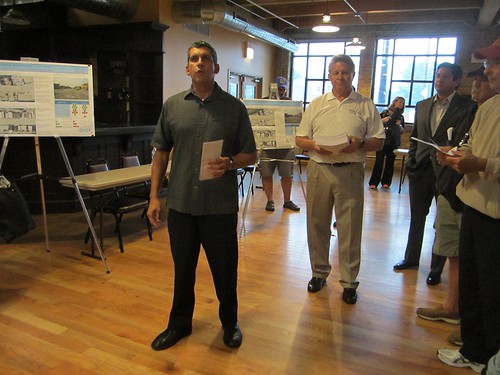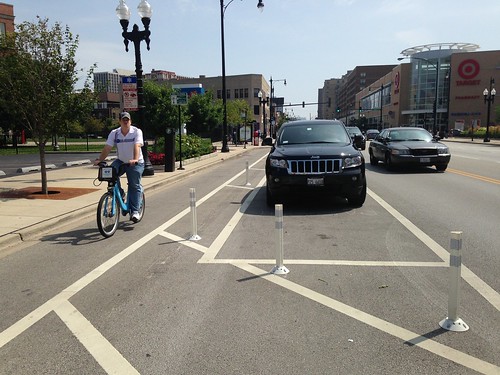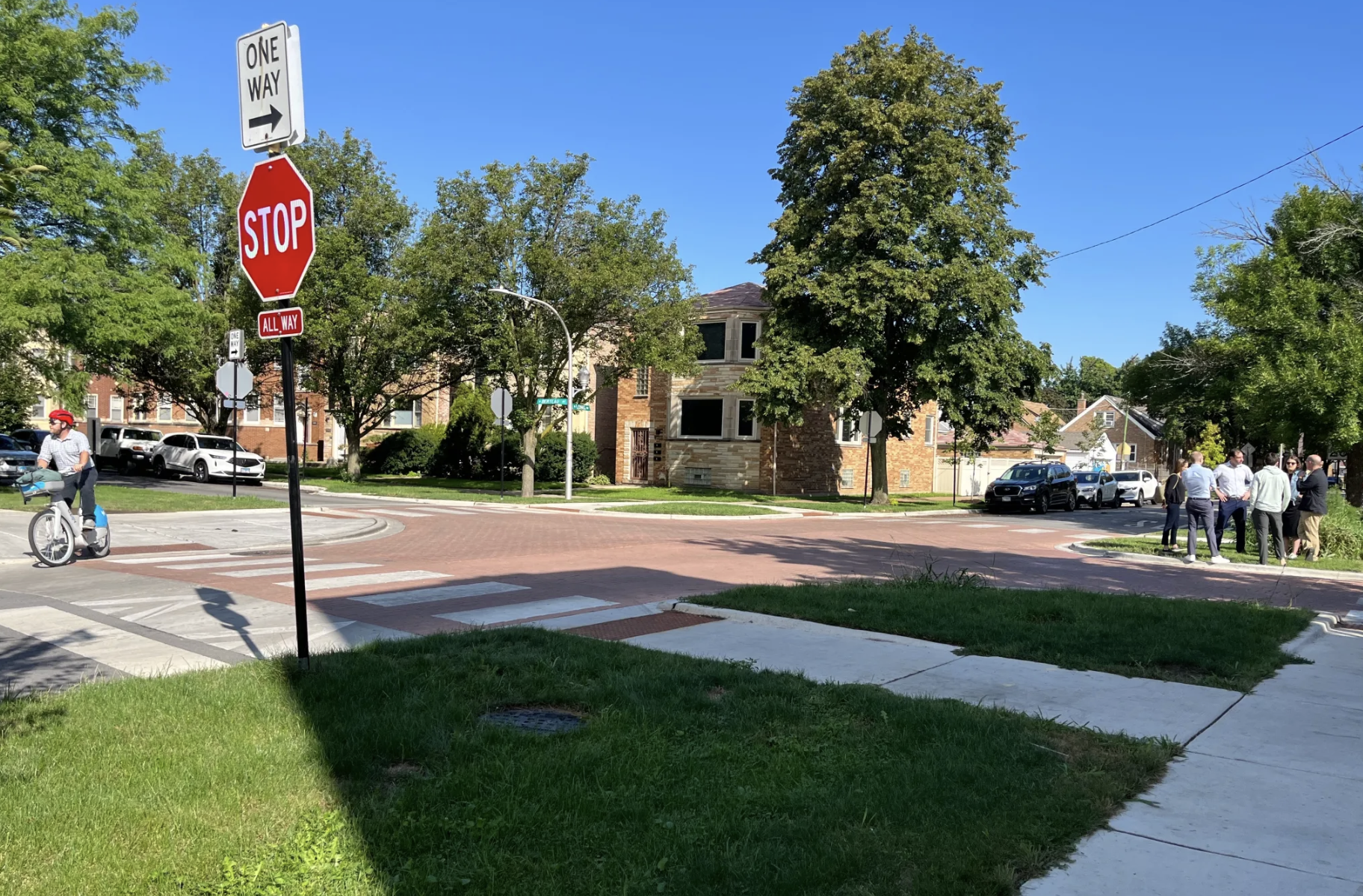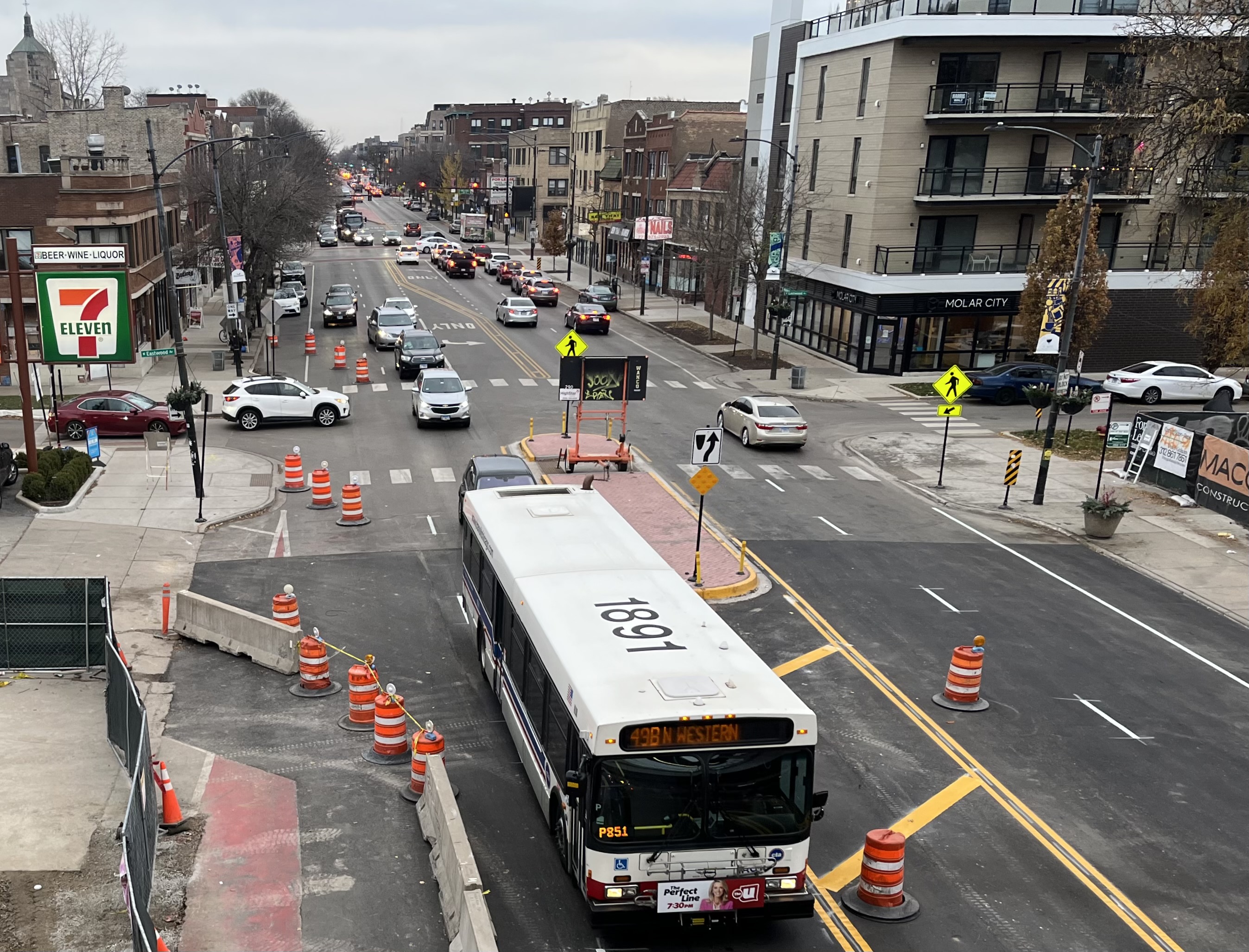The Chicago Department of Transportation has proposed three possible street reconfigurations for Milwaukee from Lawrence to Elston. Unfortunately, the one that CDOT originally said would have had the greatest safety benefit for pedestrians, bicyclists, and drivers is now off the table.
The scenario where the current five-lane speedway would have been converted to two travel lanes and a turn lane, plus protected bike lanes, is no longer under consideration, according to 45th Ward chief of staff Owen Brugh. He said that Alderman John Arena and CDOT jointly concluded that PBLs weren’t a practical solution for this stretch, due to the high number of driveways.
Since protected lanes would have involved moving the parking lanes to the left side of the bike lanes, parking spaces would have had to be eliminated at each intersection and curb cut to ensure that cyclists and motorists could see each other. This would have required the removal of 20 percent of the parking spots on Milwaukee. However, parking counts show that, in general, spaces on this section of Milwaukee are currently used as little as 50 percent of the time, and not more than 90 percent of the time, so there would be a relatively minor impact on the availability of parking.
The two other alternatives are still under consideration. One would involve a road diet with wide buffered lanes, which CDOT says would still have a significant safety benefit for all road users. The other would maintain all five lanes but add narrow buffered lanes, which would provide a minor safety benefit for cyclists and pedestrians, but have practically no effect on car speeds.
It’s a shame that protected lanes are no longer being considered, since this stretch of Milwaukee would greatly benefit from a major reboot. This section consistently averages well under 20,000 vehicles, making it the least busy stretch of Milwaukee in the city. But while Milwaukee south of the Kennedy Expressway is generally a two-lane street, north of the Kennedy it has two travel lanes in each direction, plus turn lanes, and the excess capacity encourages speeding. Recent CDOT traffic studies found that 75 percent of motorists broke the 30 mph speed limit, and 14 percent exceeded 40 mph, a speed at which studies show pedestrian crashes are almost always fatal.
Since speeding is the norm here, it’s not surprising that there’s a high crash rate. The project area saw 910 crashes between 2008 and 2012, causing at least 17 serious injuries and three deaths, according to CDOT. In January of this year, two men were killed in a rollover crash on the 6000 block of the street, just south of Elston.
Studies show that road diets work well on streets with less than 20,000 vehicles per day, and that they often improve vehicle flow by better organizing traffic, so the protected lanes likely would have little negative effect on traffic. Meanwhile, converting the excess travel lanes to PBLs would have discouraged speeding and shortened crossing distances for pedestrians, as well as improved safety for cyclists.
At an open house earlier this summer, I talked to a number of local residents who supported the PBL option. However, many neighbors were against the plan, fearing that it would create gridlock and kill local businesses. Studies have shown that road diets with protected lanes have the opposite effect on commerce.
Aldermanic candidate John Garrido, who narrowly lost to Arena in the last election, interrupted the open house to present CDOT engineers with what he said were 4,000 signatures in opposition to any reconfiguration of the street that would involve fewer travel lanes. Brugh didn’t comment on whether the petition drive influenced Arena’s decision, but he said that the alderman has not been given a copy of the petitions.
Jeff Park residents who are opposed to the possibility of a road diet should take a field trip to Broadway in Uptown to see how a road diet with protected bike lanes has created a safer, more people-friendly street. This stretch of Broadway formerly had four travel lanes, plus turn lanes at some intersections – a similar configuration as the Milwaukee project area. Earlier this year, CDOT reconfigured Broadway to have two travel lanes and a turn lane, plus PBLs from Montrose to Lawrence, and buffered lanes from Lawrence to Foster.
“It has worked out really well,” said 46th Ward chief of staff Tressa Feher. “People say they feel much more comfortable biking on Broadway now. It has also made it easier to cross the street, since there are only two [travel] lanes to cross instead of four.”
Brugh said Arena is still considering the possibility of a road diet plus buffered lanes on Milwaukee. He said CDOT is still compiling data and feedback from the public meetings, as well as consulting with the state and federal governments about the project. “Once CDOT completes that process, we’ll have a better idea of what the project will look like moving forward.”
Brugh acknowledged that something needs to be done to improve safety on Milwaukee. “I have a four-year-old daughter, and I can tell you from personal experience that it’s very hard to cross Milwaukee north of Foster with a small child, even at a stoplight. Since it’s a diagonal street laid on top of the city grid, it has very long crosswalks. I imagine it’s even more difficult for someone who is elderly and doesn’t move well.”
Regardless of which of the two remaining options are chosen, Milwaukee will get high-visibility crosswalks and pedestrian islands as part of the project. However, if Arena and CDOT are serious about improving safety they’ll move forward with the road diet with buffered lanes. That’s the one remaining option that will have a significant impact on Milwaukee’s speeding epidemic.
